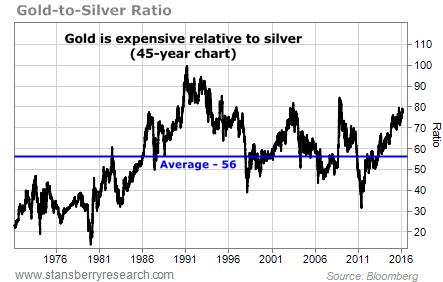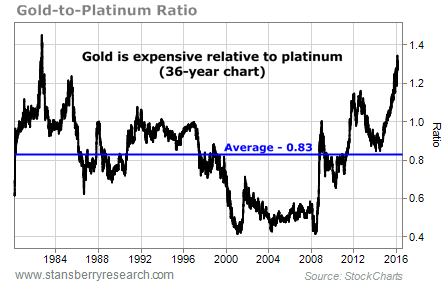Gold is notoriously difficult to value…
It’s nothing like a business. It doesn’t generate earnings. It doesn’t pay a dividend.
It used to be a currency. And it’s still kind of like one… except that it’s rarely used in trade.
[ad#Google Adsense 336×280-IA]It’s not like most commodities, either…
Most commodities – like oil, copper, cotton, and natural gas, for example – are produced and consumed.
Sometimes they’re stored for a while before they’re consumed… But that’s it.
New production and existing inventories are the supply. And consumption is the demand.
When supply outpaces demand, prices fall. When demand outpaces supply, prices rise. There’s a formula.
Gold is different. People buy it when they’re worried about the economy and the value of paper currencies. They buy it to hang around their necks or put on their wrists. They buy it and store it in safes for generations.
When’s the last time you heard about someone buying a barrel of oil or a bale of cotton… then hiding it for a few decades?
One of the best things I’ve read on this topic comes from Jack Schwager, author of the excellent Market Wizards series. In his book Hedge Fund Market Wizards, Schwager explained:
Gold is the only commodity where the amount of supply is literally about 100 times as much as the amount physically used in any year. That is not true of any other commodity, such as wheat or copper, where total supply and annual consumption are much closer in balance, and true shortages can develop. There is never any shortage of gold. So gold’s value is entirely dependent on psychology or those fundamentals that drive psychology.
What’s especially tricky is that as psychological demand (fear) rises, supply (from people’s jewelry and coins, as well as government coffers) evaporates. When everyone wants to buy, nobody wants to sell. Prices boom. Then at some point, when fear eases, lots of people want to sell… And there’s nobody left to buy. Prices bust.
What’s the fair, logical value of an asset like that?
I don’t know. It depends on the degree of fear. It depends on what happens during the next financial crisis, whenever that comes.
I don’t know what gold is worth… But I’d be willing to bet people will place a higher dollar value on it at some point in the next five years than they do right now.
So it might surprise you to hear me say that gold is expensive today…
It’s expensive relative to other precious metals, like silver and platinum. Over time, gold has had a strong positive correlation with silver and platinum. When gold goes up, silver and platinum usually go up, too. They just go up at different rates.
That’s why it makes sense to look at how far gold has gone up or down relative to silver… and how far it has gone up or down relative to platinum. By looking at ratio charts, you can see which of the metals are relatively cheap… and which are relatively expensive.
The ratio chart of gold to silver below shows how many ounces of silver it “cost” to buy one ounce of gold over the last 45 years. The average is 56 ounces of silver to one ounce of gold. Today, it costs 78 ounces of silver to buy an ounce of gold. As you can see, gold was more expensive in the early 1990s… But other than that, it’s nearly as expensive as it has ever been.

Now, let’s look at how much platinum it “costs” to buy an ounce of gold…
In the 36-year chart below (as far back as we have data), you can see that gold is extremely expensive relative to platinum, too. The average is 0.83 ounces of platinum to one ounce of gold. In other words, platinum is usually more expensive than gold (21% more expensive, on average). Today, an ounce of gold “costs” 1.27 ounces of platinum. Again, by this measure, gold is nearly as expensive as it has ever been.

What should you take away from all this?
You can buy gold today. If you don’t already have some of your wealth stored in gold, I suggest you buy it. But we know that it’s relatively expensive…
So if you were thinking about buying gold, you may want to focus the majority of your purchases on silver and platinum instead. They’re the bargains of the precious metals world.
Regards,
Ben Morris
[ad#stansberry-ps]
Source: Growth Stock Wire


